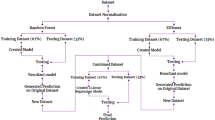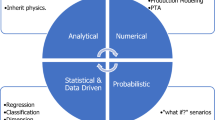Abstract
The process of cement manufacturing is both energy intensive and difficult to control. This complicated process results in inefficiencies in energy consumption and variations in cement quality with many complex influencing process factors such as input raw materials, variable fuels, firing conditions including temperature, burning, and reside time. Therefore, in order to address these challenges and investigate the effect of parameters and system optimization, the processes must be modeled first. This predictive model will be used to support process energy use reductions while maintaining and improving product quality. This article presents a study on the use of machine learning models to predict clinker kiln flow rate based on process parameters. The study tested different models such as linear regression, Extra Trees regressor, random forest, K-nearest neighbor, XGB regressor, and neural network and found that the linear regression model performed the best due to its ability to handle overfitting pretty well using dimensionally reduction techniques, regularization, and cross-validation. In fact, the predictive model found enable to predict kiln feed rate at an early stage based on a total of 91 significant input parameters and enable to make future suggestions for action to optimize the control of the kiln process. The findings have significant implications for the process and operation related to the kiln performances which implies potential reduction in terms of energy consumption and gas emissions and improvement of operational efficiency.







Similar content being viewed by others
References
Rodrigues FA, Joekes I (2010) Cement industry: sustainabilit. Environ Chem Lett 9(2):151–166
Aghdasinia H, Hosseini SS, Hamedi J (2021) Improvement of a cement rotary kiln performance using artificial neural network. J Ambient Intell Human Comput 12:7765–7776
Wurzinger A, Leibinger H, Jakubek S, Kozek M (2019) Data driven modeling and nonlinear model predictive control design for a rotary cement kiln. IFAC-PapersOnLine 52(16):759–764
Kumar N, Naranje V, Salunkhe S (2020) Cement strength prediction using cloud-based machine learning techniques. J Struct Integr Maint 5(4):244–251
Mirmozaffari M, Yazdani M, Boskabadi A, AhadyDolatsara H, Kabirifar K, AmiriGolilarz N (2020) A novel machine learning approach combined with optimization models for eco-efficiency evaluation. Appl 10:5210
Narciso DAC, Martins FG (2020) Application of machine learning tools for energy efficiency in industry: a review. Energy Rep 6:1181–1199
Kim D-H, Kim TJY, Wang X, Kim M, Quan Y-J, Oh JW, Min S-H, Kim H, Bhandari B, Yang I et al (2018) Smart machining process using machine learning: a review and perspective on machining industry. Int J Precis Eng Manuf Technol. 5:555–568
Choi H, Park S (2021) A survey of machine learning-based system performance optimization techniques. Appl Sci 11:3235
Zhang K, Wang J, Xin X, Li X, Sun C, Huang J, Kong W (2022) A survey on learning-based model predictive control: toward path tracking control of mobile platforms. Appl. Sci. 12:1995
Ali AM, Tabares JD, McGinley MW (2022) J Adv Manuf Process 4(4):e10137
Malley B, Ramazzotti D, Wu JT (2016) Data pre-processing. In: Secondary analysis of electronic health records. Springer, Cham, pp 115–141
Han J, Kamber M, Pei J (2012) 3 - Data preprocessing. In: Han J, Kamber M, Pei J (eds) Data mining, 3rd edn. Morgan Kaufmann, Boston, pp 83–124
Järvinen P, Siltanen P, Kirschenbaum A (2021) Data analytics and machine learning. In: Big data in bioeconomy. Springer, Cham, pp 129–146
Heo J, Yoon JG, Park H et al (2019) Machine learning-based model for prediction of outcomes in acute stroke. Stroke 50:1263–1265
Doan T, Kalita J (2015) Selecting machine learning algorithms using regression models. In: 2015 IEEE International Conference on Data Mining Workshop (ICDMW), pp 1498–1505
Battineni G, Sagaro GG, Nalini C, Amenta F, Tayebati SK (2019) Comparative machine-learning approach: a follow-up study on type 2 diabetes predictions by cross-validation methods. Machines 7:74
Botchkarev A (2019) Performance metrics (error measures) in machine learning regression, forecasting and prognostics: properties and typology. Interdiscip J Inf Knowl Manag 14:045–076
Chai T, Draxler RR (2014) Root mean square error (RMSE) or mean absolute error (MAE). Geosci Model Dev Discuss 7(1):1525–1534
Acknowledgements
The authors would like to thank all the stakeholders of this project and particularly the engineers and technicians of the cement plant where our research were conducted.
Author information
Authors and Affiliations
Contributions
All authors contributed to the study conception and design. Material preparation, data collection, and analysis were performed by M.T. Benchekroun and S. Zaki. The first draft of the manuscript was written by M.T. Benchekroun, and all authors commented on previous versions of the manuscript. All authors read and approved the final manuscript.
Corresponding author
Ethics declarations
Conflict of interest
The authors declare no competing interests.
Additional information
Publisher's note
Springer Nature remains neutral with regard to jurisdictional claims in published maps and institutional affiliations.
Rights and permissions
Springer Nature or its licensor (e.g. a society or other partner) holds exclusive rights to this article under a publishing agreement with the author(s) or other rightsholder(s); author self-archiving of the accepted manuscript version of this article is solely governed by the terms of such publishing agreement and applicable law.
About this article
Cite this article
Toum Benchekroun, M., Zaki, S. & Aboussaleh, M. Kiln predictive modelization for performance optimization. Int J Adv Manuf Technol 127, 1333–1339 (2023). https://doi.org/10.1007/s00170-023-11563-2
Received:
Accepted:
Published:
Issue Date:
DOI: https://doi.org/10.1007/s00170-023-11563-2




